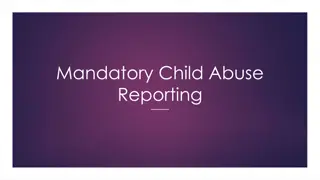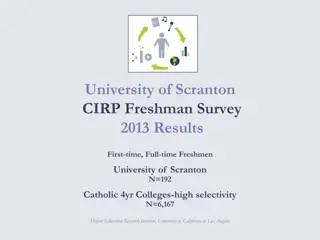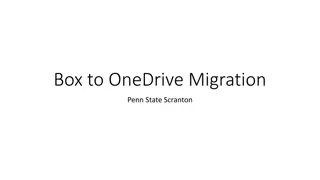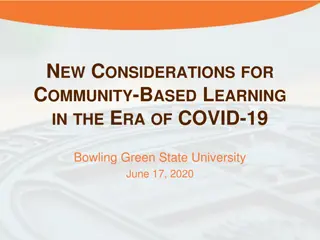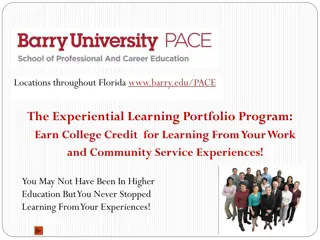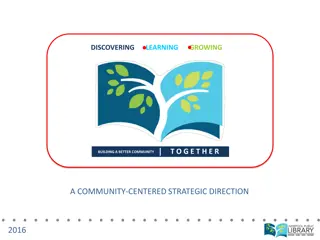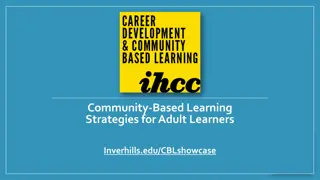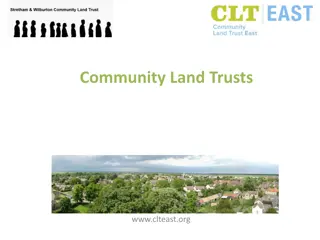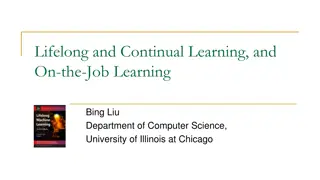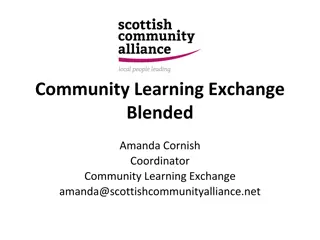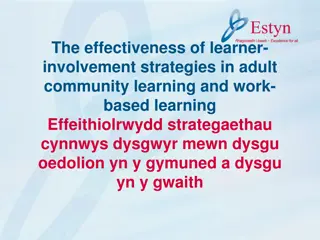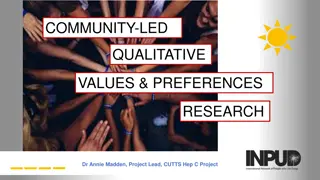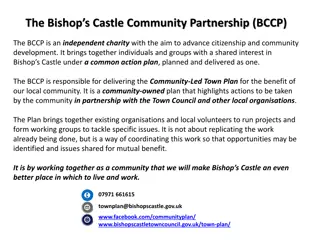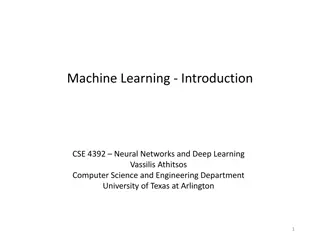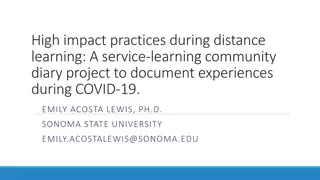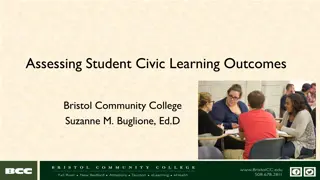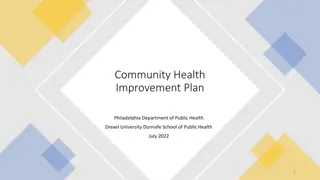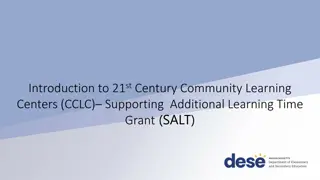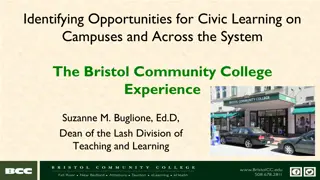Understanding Community-Based Learning at the University of Scranton
Community-Based Learning (CBL) at the University of Scranton integrates theory with practice, engages students with community members, and fosters critical reflection. It prepares students to address societal challenges, identify systemic issues, and nurture a sense of commitment towards underserved communities. CBL differs from volunteerism and community service by emphasizing academic learning, structured engagement, and personal development. The approach emphasizes meeting community-defined needs while promoting a global perspective rooted in Jesuit and Catholic values.
Download Presentation

Please find below an Image/Link to download the presentation.
The content on the website is provided AS IS for your information and personal use only. It may not be sold, licensed, or shared on other websites without obtaining consent from the author. Download presentation by click this link. If you encounter any issues during the download, it is possible that the publisher has removed the file from their server.
E N D
Presentation Transcript
Community-Based Learning Meghan Ashlin Rich, Faculty Coordinator Office of Community-Based Learning University of Scranton
What is Community-Based Learning? Community-Based Learning (CBL) is an academic experience that involves students working with individuals, groups, or organizations in ways structured to meet community-defined needs.
What is Community-Based Learning at the University of Scranton? In keeping with the Jesuit, Catholic mission of The University of Scranton, CBL incorporates a global perspective and understanding through integration of theory with practice, direct engagement with community members and personal and critical academic reflection. Community-Based Learning prepares students to understand common challenges facing humanity, identify systemic problems, and develop a commitment to their communities, especially people who live and work in poverty, illness, inequality, hopelessness, and other social disparities.
How is CBL different from other types of service or experiential learning programs? Volunteerism Community service Community-Based Learning (or Service-Learning) Field education Internship
How is CBL different from other types of service or experiential learning programs? Recipient Beneficiary Provider Service Focus Learning Community-Based Learning Community Service Field Education Volunteerism Internship *adapted from Furco, A. (1996). Service-learning: A Balanced Approach to Experiential Learning. Washington, DC: Corporation for National and Community Service.
Volunteerism Emphasis is on the service being provided Benefits the service recipient Often occurs one-time or sporadically A form of charity No explicit academic learning involved
Community Service Also a form of charity Primary focus is on the service being provided Tend to be more structured and tied to learning outcomes for students Not usually tied to a course or academic program; may not involve reflection Examples: hunger awareness in community; graffiti taskforce
Internships/Field Placements Provides students with hands-on learning experiences tied to their academic area of study. Do not have to be tied to an academic course or involve reflection. Primary focus is on learning for student; not service or community oriented. Field placements may benefit the recipients but the focus is still on student learning and career preparation.
Community-Based Learning Equally benefits the student and the community; based in community-defined needs. Equal focus on the service being provided and student learning. Learning should not be based in just experience of service; tied to curriculum, course learning outcomes, and critical reflection. CBL integrates service into courses/academic programs.
How is CBL different from Service Learning? It isn t Different institutions prefer different names for similar programs University of Maryland: community service-learning University of Pennsylvania: academically based community service Service learning is the most common name The University of Scranton chose to change SL to CBL to reflect our emphasis on the tie between community-defined needs and the academic learning experience.
Who is the Community? There is no one definition of community The university and the community are not separate entities, but may have competing interests It can include local, national, or global communities Community-based organizations are the most common partners for CBL Otherwise, CBL can be sporadic and not sufficiently organized An ideal partnership matches up the academic strengths and goals of the university with the assets and interests of the community (Ramaley 2000: 241).
Why Do CBL? Student Learning Outcomes It is considered a high impact educational practice Students invest more time and effort in learning Participation in active learning experiences Experience diversity and observe first-hand the effects of racism, poverty, and inequality; reduces stereotyping and facilities cultural understanding Real-world experiences tied to their learning experiences Students engage with communities to solve real-life problems Ties theory to praxis Personal growth and a sense of moral and spiritual responsibility Heightens critical thinking and academic engagement Supports engaged citizens From: Jacoby, Barbara. (2015). Service-Learning Essentials: Questions, Answers, and Lessons Learned. San Francisco: Jossey- Bass.
Barriers to CBL for Faculty It s time consuming. There is little funding or recognition for CBL courses. It is unpredictable from semester to semester. Logistical issues (transportation, waivers, background checks) It can be difficult to find an organization to partner with. Time limits of a semester-long class. Unsure how to oversee student work outside of regular class time. Unsure how to assess student impact on organization and learning outcomes. Class size too large or too small to do a useful project.
Why do CBL? Benefits for Faculty It is a high impact, engaging pedagogy. It ties academic disciplines and expertise to community- defined needs. It can provide opportunities for faculty and student research. It is a form of community service. It encourages interdisciplinary partnerships as faculty work with other CBL faculty on courses and projects. As CBL is valued more by university administration and within disciplines, more opportunities for professional development, community partnerships, and publications
Why Do CBL? Community Engagement Outcomes Assists community organizations needs such as (Jacoby, 2015): the ability to offer expanded services and programs internal assessment client/community data collection grant application processes adding to organization visibility and fundraising better understanding of community needs through research Pitfalls for community organizations to engage in service learning (Stoecker, 2016): It is an inherently unequal power relationship between student (university) and client (community) Students are usually not trained in the activity they are engaged in Most service does nothing to solve social problems It takes up time and resources to train and oversee students
Principles of Good Practice in Community-Based Learning Programs Engages people in responsible and challenging actions for the common good Provides structured opportunities for people to reflect critically on their service experience 1) 2) Articulates clear service and learning goals for everyone involved Allows for those with needs to define those needs Clarifies the responsibilities of each person and organization involved 3) 4) 5) (From: Porter-Honnet, E. & Poulsen, S.J. 1990. Principles of Good Practice in Combining Service and Learning. In Combining Service and Learning. Raleigh, NC: National Society for Internships and Experiential Education).
Principles of Good Practice in Community-Based Learning Programs Matches service providers and service needs through a process that recognizes changing circumstances Expects genuine, active, and sustained organizational commitment Includes training, supervision, monitoring, support, recognition, and evaluation to meet service and learning goals. Insures that the time commitment for service and learning is flexible, appropriate, and in the best interest of all involved. 10) Is committed to program participation by and with diverse populations. 6) 7) 8) 9) (From: Porter-Honnet, E. & Poulsen, S.J. 1990. Principles of Good Practice in Combining Service and Learning. In Combining Service and Learning. Raleigh, NC: National Society for Internships and Experiential Education).
Constructing a CBL Course
Constructing a CBL Course 1) State your desired learning outcomes Action verbs and concrete, measureable terms Example: Apply a sociospatial framework to urban social problems, such as racial segregation, poverty, and crime. (Rich, 2018) From: Jacoby, Barbara. (2015). Service-Learning Essentials: Questions, Answers, and Lessons Learned. San Francisco: Jossey-Bass.
Constructing a CBL Course Select learning outcomes that are best addressed through service learning Using a discipline s knowledge base to address complex social issues Synthesis and analysis of information to solve complex problems with multiple possible solutions Understanding the effects of power and privilege on individuals and society Examining structural effects on society Effective oral written and visual communication Exercise of well-reasoned judgement Taking ownership for learning Developing the skill and habits of critical reflection Other outcomes that involve manipulating, relating, structuring, developing, interpreting, decisions making, prioritizing, and like skills. 2) From: Jacoby, Barbara. (2015). Service-Learning Essentials: Questions, Answers, and Lessons Learned. San Francisco: Jossey-Bass.
Constructing a CBL Course 3) Envision the service experience that will serve as a primary course text Required service and number of hours, frequency, and length? Particular project for course or ongoing activity? Direct, nondirect, or indirect? One site or multiple sites?
Constructing a CBL Course 4) Select other course content and pedagogies Depends on level and subject of class: Theory and practice of service learning; the community and social contexts; historical and theoretical perspectives; roots causes of needs to be addressed; knowledge needed for students CBL experience Readings; guest speakers; field trips; class discussions; presentations; papers; journals; group projects
Constructing a CBL Course 5) Seek potential community partners After meeting first with Office of CBL to discuss course goals, connect with the Center for Service and Social Justice (social service) or Office of Community and Government Relations (civic) to identify partner(s) Meet with a potential community partner Consider the mission, projects, site location(s), client population, schedule, student capacity, and skills needed from students
Constructing a CBL Course Integrate critical reflection thoroughly into the course 6) When, where, and how reflection will occur What kinds of prompts will you provide? How will you assess critical refection? Journals, in-class group or online discussion, and final papers The What? So What? Now What? Reflection Model **The goal of critical reflection is for students to understand the root causes of the need for their service** From: Jacoby, Barbara. (2015). Service-Learning Essentials: Questions, Answers, and Lessons Learned. San Francisco: Jossey-Bass.
Constructing a CBL Course 7) Develop a plan to assess student and community outcomes When and how to assess Community partner s role in assessment of student Assessment of service impact on community partner Course evaluation of student learning (outside of University evaluation system)
Constructing a CBL Course 8) Address logistical issues Course approval Transportation and waivers Background checks required Scheduling of student orientation and projects Student training in skills needed and appropriate attitude/conduct/appearance
References and Guides for CBL Dolgon, C., T. D. Mitchell, and T. K. Eatman (Eds.) (2017). The Cambridge Handbook of Service Learning and Community Engagement. Cambridge UK: Cambridge University Press. Furco, Andrew. (1996). Service-Learning. A Balanced Approach to Experiential Learning. Pp. 2-6 in Expanding Boundaries: Serving and Learning. Washington, DC: Corporation for National Service. Heffernan, Kerrissa. (2001). Fundamentals of Service-Learning Course Construction. Providence, RI: Campus Compact. Jacoby, Barbara. (2015). Service-Learning Essentials: Questions, Answers, and Lessons Learned. San Francisco: Jossey-Bass. Stoecker, Randy. (2016). Liberating Service Learning and the Rest of Higher Education Civic Engagement. Philadelphia, PA: Temple University Press. https://compact.org/


